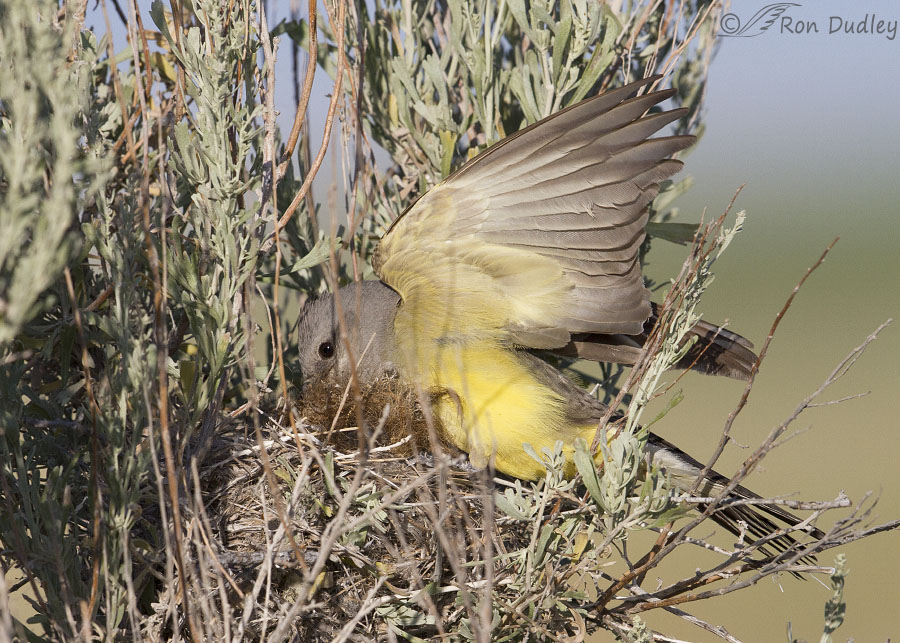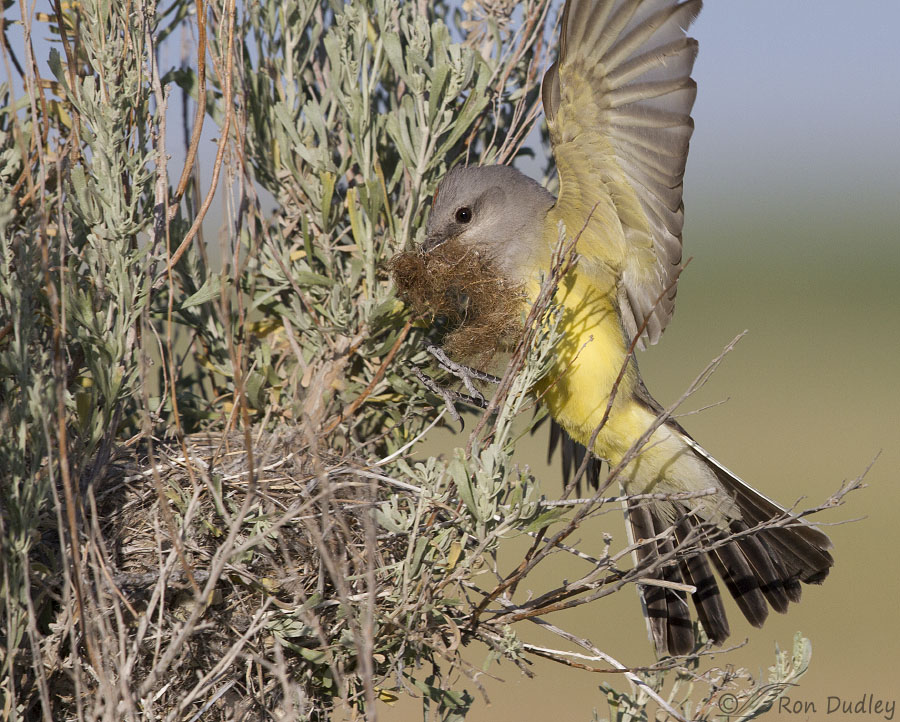It isn’t a nesting material you see every day.

1/3200, f/7.1, ISO 500, Canon 7D, Canon EF 500mm f/4L IS II USM, not baited, set up or called in
Here the female of a mated pair has just landed on top of their nest in sagebrush with nesting material in her bill (in this species only females build nests). If I tell you that the photo was taken on Antelope Island can you guess what the nesting material is?
It’s bison hair. I’ve seen and documented Loggerhead Shrikes and even a Common Raven carrying bison hair to their nests several times over the years but this was a first for me with Western Kingbirds. I watched as she carried nesting material dozens of times but this was the only instance where it was anything but small twigs or dried grass, as evidenced by the nest itself. Perhaps she was beginning to line the inner nest cup with softer materials.
Normally it would have been very tricky for me to get this bird’s head sharp while she was on the nest in this position because of all the twigs sticking up in the foreground but here I had an advantage because I had my…

1/3200, f/7.1, ISO 500, Canon 7D, Canon EF 500mm f/4L IS II USM, not baited, set up or called in
active focus point locked on her in the previous image in the burst just before she made touchdown on the nest (notice her extended feet). So the focus point stayed locked on the bird for the next photo.
I like to photograph firsts and for me this was a first with a Western Kingbird using bison fur as nesting material. They’re only documentary quality images but I’ll take them anyway.
Ron
Note: It may seem illogical for me to present the two photos out-of-order like I did but I wanted to make a point about how my focus points worked and that seemed like the most effective way to do it.


Wow. Beautiful shots
Really terrific photos! I love pictures that ‘tell a story’…that is what your photos do and I really appreciate them. Several of the birds you document we don’t see here and I’m sure, reading the posts, I’m not the only one so it’s nice to see the behaviors of other birds; some similar and some quite different. I enjoy the learning process of their behavior. It sure would make sense to use something ‘warm and fuzzy’ for the little ones. I’ve watch many Black-Capped Chickadees rip and tug at old cat-tail heads to get the fuzzy stuff for nesting material.
Thanks, Kathy. When it comes to cat-tail “fuzz” the bird I most often see using it for nesting material is the Marsh Wren. Don’t think I ever see chickadees in the marshes.
We have cat-tails growing everywhere here along the roads and edges of the woods…too many of the invasive types in fact crowding out the native one and other native plants. Such is the life of invasive species.
Add me to the chorus who likes (LOVES) your documentary series. Learning, and almost always seeing incredibly beauty. Mind you, my ignorant self wasn’t surprised that it was bison fur. I assumed that most (all?) birds line their nests with something soft. Am I wrong?
I don’t think they all do, EC. For example, Mourning Dove nests are simple platforms to hold eggs and young, they have little structure. All Prairie Falcons do for a nest is crape some nearby debris to form a small depression that has no structure at all. Seems like there are others too…
Thank you. As I said, learning all the time. I suspect my comfort loving self was thinking of self again.
I did know that some birds just scrape out a precarious spot on the ground. Mind you, while they are used for nesting, I don’t think of those scrapes as nests (if that makes sense).
I was actually able to guess the nesting material – between the color and your hint it was actually easy. It’s nice that you were able to keep the bird’s head sharp. After yesterday’s post I thought about you as I watched a Barn Swallow come in to feed one of its three youngsters today.
Thanks for thinking of me, Susan! 🙂 And congrats on your accurate guess.
Funny, but the nesting material looks like the “fluff” that grows on a bush in our yard. {Sorry I don’t know the name].
Anyway, very interesting photos of this bird and its nest building.
Thank you, Ron
I couldn’t even guess at what kind of plant you have, Alice. Thanks.
I’m with Dick Harlow–I LIKE the documentary images a LOT! I really like seeing what they do in their daily lives. You know, the things most humans don’t see because we’re not out there chronicling what they do in their daily lives.
Ms. Kingbird is lining her nest cup with soft-ish stuff, just like redtails do (although they’re likely to use shredded bark that they shred while no one is looking). I wonder if Ms. Kingbird acquired her bison fur fresh from the bison OR if she collected some fur that had been shed? See how one answer opens up a whole bunch more questions? I love that about learning.
Anyway, chickadees in Dallas would swipe fur from Maggie the Golden Wondermutt as she blew her coat in the spring. They were utterly fearless about grabbing it right off her back! Maggie didn’t seem to mind much, but I’d also put wads of her no-longer-needed fur out for the birds. It’s much safer than string in terms of tangling baby birds AND it’s really, REALLY soft. That, and I’ve always got PLENTY of dog fur hanging around here! 🙂
“I wonder if Ms. Kingbird acquired her bison fur fresh from the bison OR if she collected some fur that had been shed?”
I’d guess it was the latter, Laura but you never know. Some birds like magpies and cowbirds spend lots of time perching on bison but they’re usually collecting insects.
Kudos for catching this nesting activity. I notice in the second photo a bit of red on the crown None of my books show or mention it, so I googled it and the only site that showed this was your entry of August 21, 2014!
Good eye, Lyle. I noticed it too. Yes, I’ve posted about their red crown patch several times. Most folks never see it (or at least notice it) in this species because they don’t reveal it very often.
Wonderful photos…Bluebirds used to use our horse’s hair, these birds use bison hair…Mother Nature is a tough broad but her timing is great…ex. the Kingbird’s use soft bison hair–shed at just the right time for nest building…
Yup, makes me wonder if bison hair used to be a staple for kingbirds when building nests on the plains, Patty.
Great shots! Amazing nesting material.
Charlotte
Thank you, Charlotte.
I knew bisons played an important part in the Indians of the Planes culture. I did not knew they also contribute to the welfare of other creatures.
From your explanation I guess you always fire a burst to be sure that the active focus point is where you want it to be?
Thank you for showing those interesting images.
“I guess you always fire a burst to be sure that the active focus point is where you want it to be?”
Not necessarily, Jorge. It depends on the situation. Thank you.
Extra degree-of-difficulty points for getting her so perfectly sharp, Ron! That clump of bison hair just makes it for me! I also really like the nest detail you picked up — so cool to see the individual components.
I generally leave the “discards” from brushing the cat outside during the spring and summer months as well as those from my own hairbrush (although I’ll be cutting those into shorter pieces now — never thought of the babies getting tangled). At the shelter, I’ve seen birds pick up stray puffs of fur and even some brazen (or stupid) birds try to get the puffs directly off the Huskies or GSDs who blow their undercoats.
Some birds can get pretty creative with nesting material. Sometimes that serves them well and sometimes it doesn’t. Thanks, Marty.
Very interesting. The second shot was my favorite
Thanks, Arwen.
Very interesting photos Ron. Having no knowledge of Antelope Island I would never have guessed what that material was.
Everett Sanborn, Prescott Arizona
Thank you, Everett.
Neat! Certainly would be soft tho I sometimes worry about nestlings getting tangled in a “clump” of things like that. Birds are creative about what they will use including frayed tarp strips – blue – and of course, old mop head strands etc. Glad you captured it! We have no Western King Birds this year – only Eastern which, with no Western’s in the yard are further in the yard than usual.
Judy, I saw at least one record of kingbird chicks getting tangled up in string their parents used for the nest.
I like documentary images, and these images are fantastic! I think you are looking at one smart female. Her eggs are going to be nestled into some soft comfort!
Thanks for sharing.
If I had to sit in that nest as long as she needs to I’d want it to be as soft as possible too, Dick. Thanks.